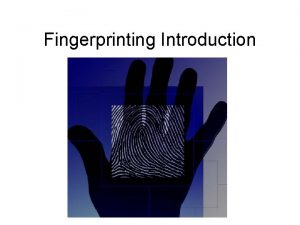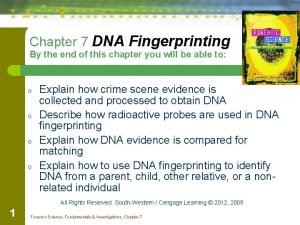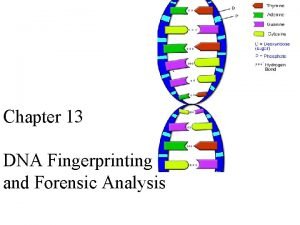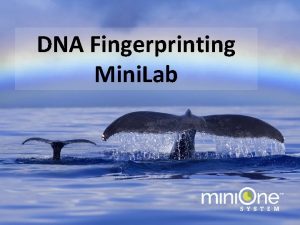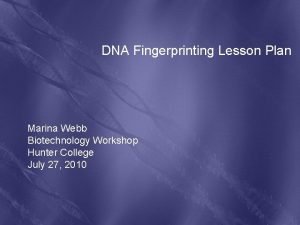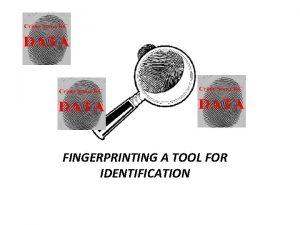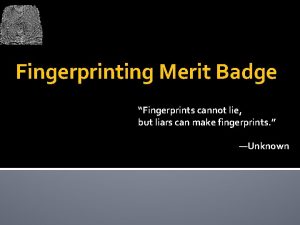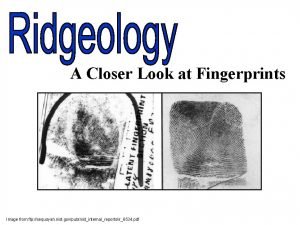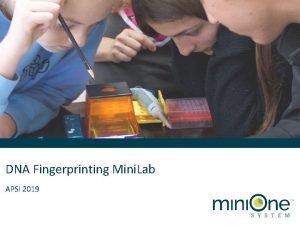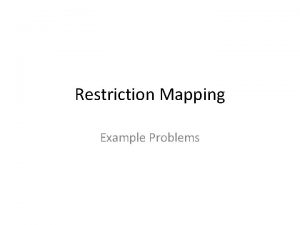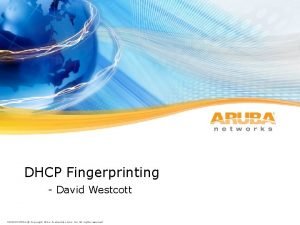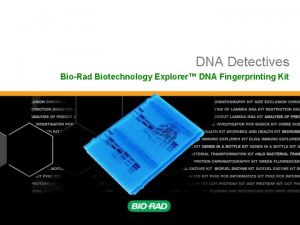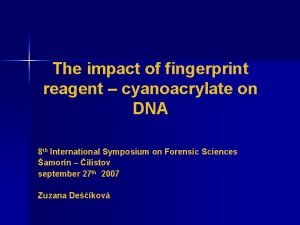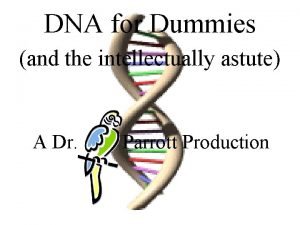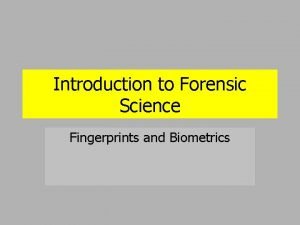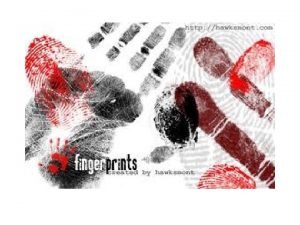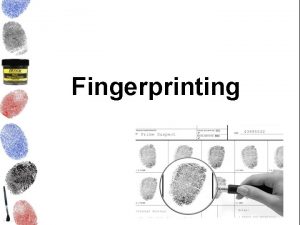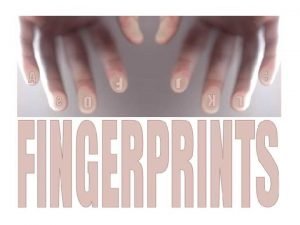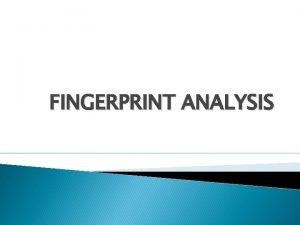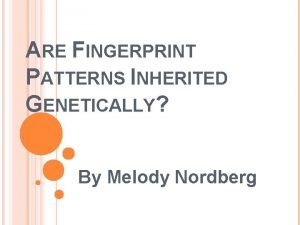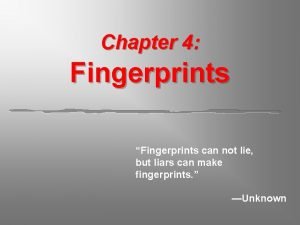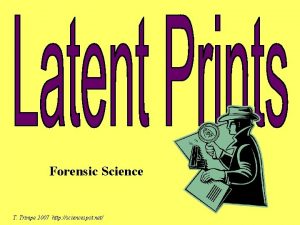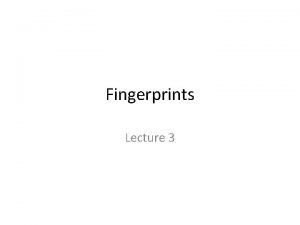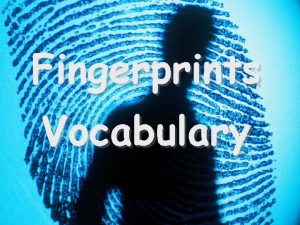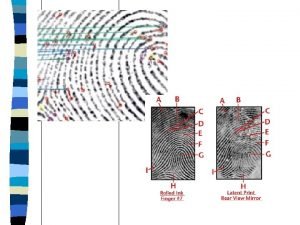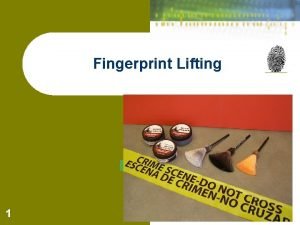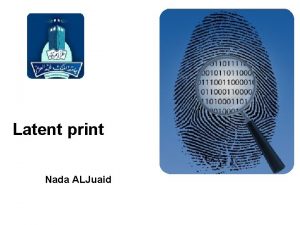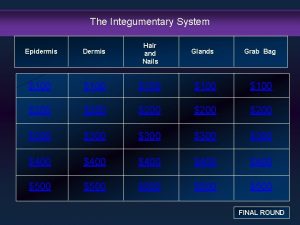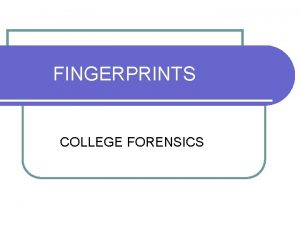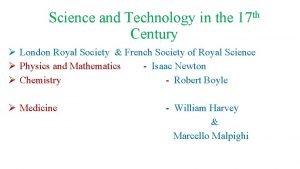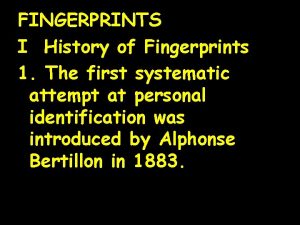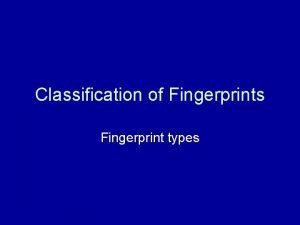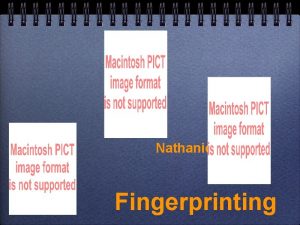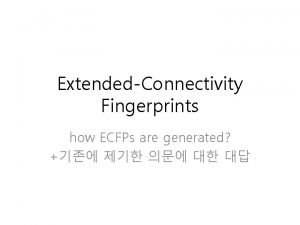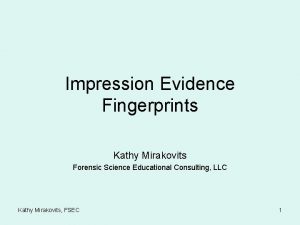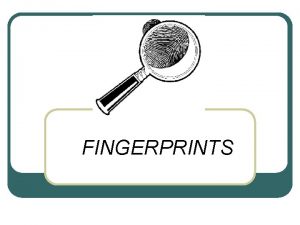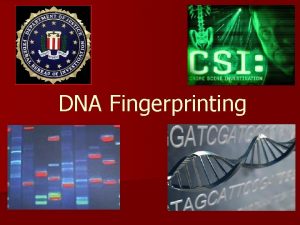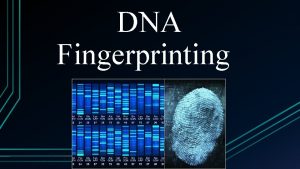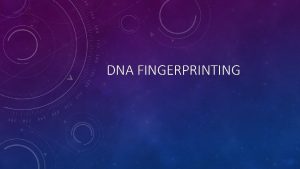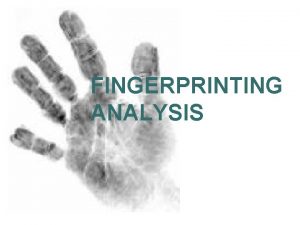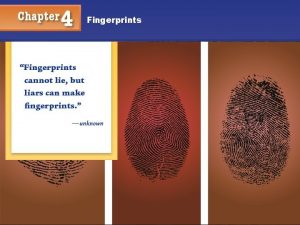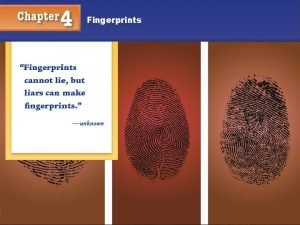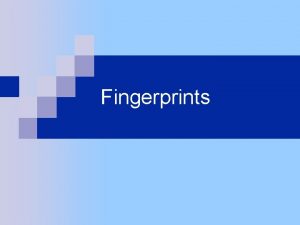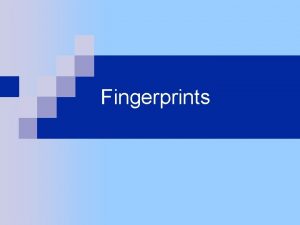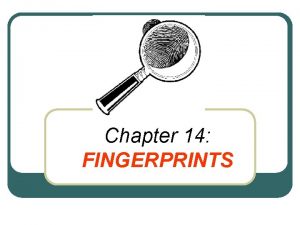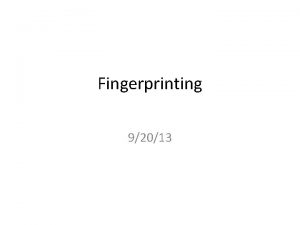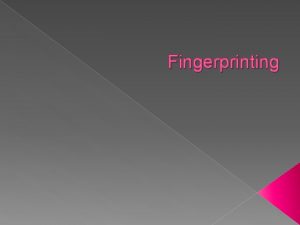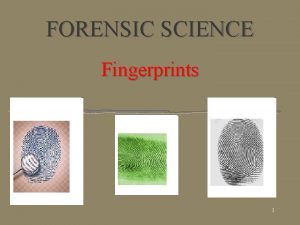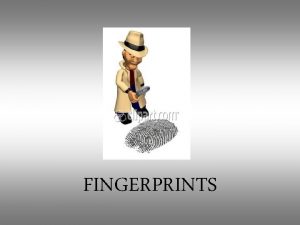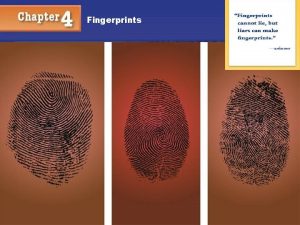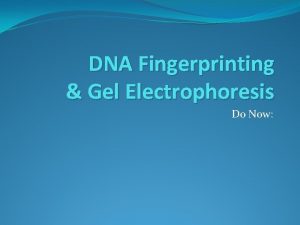FINGERPRINTS History of Fingerprints HISTORY OF FINGERPRINTING l















































- Slides: 47

FINGERPRINTS

History of Fingerprints

HISTORY OF FINGERPRINTING l l Chinese used fingerprints to sign legal documents as far back as three thousand years ago William Herschel, an English civil servant (India), required natives to sign contracts with an imprint of their right hand – Hindu custom?

HISTORY OF FINGERPRINTING l l In 1880, Scottish physician, Henry Fauld wrote that skin ridge patterns could be important in identification work A thief left his fingerprint on a whitewashed wall – compared with 1 st suspect - No match; compared with 2 nd suspect with positive association

HISTORY OF FINGERPRINTING l l l Fauld offered to set up a system of fingerprints at Scotland Yard (at his own expense) Rejected in favor of the Bertillon System This decision reversed less than two decades later

HISTORY OF FINGERPRINTING l The first systematic attempt at personal identification was devised and introduced by the French police expert, Alphonse Bertillon, in 1883.

Bertillon’s System Relied on: l Portraite Parlé – Detailed description of the individual l Full length and profile photographs l Anthropometry – A system of precise body measurements

ANTHROPOMETRY l l l A method of identification Based upon the premise that the dimensions of the human skeletal system remained fixed from age 20 until death Eleven (11) measurements taken - to include height, width of head & length of left foot

FRANCIS GALTON l l l In 1892, published the classic work Finger Prints In this book he discussed the anatomy of fingerprints and suggested methods for recording them Proposed three pattern types: loops, whorls and arches

FRANCIS GALTON l l No two prints are identical An individual’s prints remain unchanged from one year to the next

SIR EDWARD HENRY l l l Englishman In 1897, proposed another classification system which is still in use today Most English-speaking countries use some version of Henry’s classification system

In the United States l l l 1901 – First systematic use of fingerprints adopted by the New York Civil Service Commission 1904 – American police received training in fingerprint techniques from Scotland Yards representatives 1924 – Fingerprint records from the Bureau of Investigation and Leavenworth merged to form records for the new FBI

Admissibility of Fingerprints l l l Challenged in the case of United States v. Byron C. Mitchell Argued under Daubert guidelines that fingerprints were not unique Judge upheld admissibility and ruled: 1. Human friction ridges are unique and permanent 2. Human friction ridge skin arrangements are unique and permanent

PHYSIOLOGY OF FINGERPRINTS

FUNDAMENTALS OF FINGERPRINTS FIRST PRINCIPLE: Friction Ridges develop their Unique form in the fetus

FUNDAMENTALS OF FINGERPRINTS SECOND PRINCIPLE: A Fingerprint will remain LARGELY UNCHANGED during an Individual’s Lifetime

FUNDAMENTALS OF FINGERPRINTS THIRD PRINCIPLE: Friction Ridge Patterns and their details are UNIQUE No Two Fingers have yet been found to possess IDENTICAL RIDGE CHARACTERISTICS (even identical twins!!)

FUNDAMENTALS OF FINGERPRINTS FOURTH PRINCIPLE: FINGERPRINTS CAN BE SYSTEMATICALLY CLASSIFIED by GENERAL RIDGE PATTERNS

FUNDAMENTALS OF FINGERPRINTS MINUTIAE - Ridge Characteristics Define Individuality • • • IDENTITY NUMBER RELATIVE LOCATION COMPARE POINT BY POINT POSSIBLY 150 POINTS ON THE AVERAGE FINGERPRINT

FUNDAMENTALS OF FINGERPRINTS MINUTIAE - Ridge Characteristics Define Individuality HOW MANY POINTS MAKE A MATCH? Depends on experience and knowledge of the examiner Usually 8 to 16

FUNDAMENTALS OF FINGERPRINTS FRICTION SKIN RIDGES Palm Side of Fingers and Thumbs Soles of Feet Provide Firmer Grasp Resistance to Slippage Lines corresponding to Hills (ridges) & Valleys (grooves)

SKIN COMPOSED OF LAYERS OF CELLS EPIDERMIS - OUTER DERMIS - INNER LAYER DERMAL PAPILLAE IN BETWEEN

SKIN RIDGES CONTAIN PORES Openings for ducts from sweat glands Perspiration discharged to surface of skin Transfer is called LATENT FINGERPRINTS

FUNDAMENTALS OF FINGERPRINTS ARCHES 5% LOOPS 60% - 65% WHORLS 30% - 35%

FUNDAMENTALS OF FINGERPRINTS ARCHES - least common of three general patterns • RIDGES ENTER ONE SIDE OF PATTERN AND EXIT ANOTHER • • PLAIN ARCHES - wavelike pattern TENTED ARCHES - sharp spike

FUNDAMENTALS OF FINGERPRINTS • • • LOOPS - most common type Ridges enter one side and exit same side ULNAR LOOP - opens toward little finger RADIAL LOOP - opens toward thumb

FUNDAMENTALS OF FINGERPRINTS LOOPS - • CORE • TYPE LINES • DELTA

FUNDAMENTALS OF FINGERPRINTS WHORLS - FOUR TYPES • • l Plain Central pocket loop Double loop Accidental ALL HAVE TWO DELTAS & TYPE LINES

FINGERPRINT DEVELOPMENT

Types of Fingerprints VISIBLE RIDGES PLACED ON A SURFACE AFTER CONTACT WITH A COLORED MATERIAL (blood, paint, grease, ink)

Types of Fingerprints PLASTIC RIDGES LEFT ON A SOFT MATERIAL (putty, wax, soap, dust)

Types of Fingerprints LATENT HIDDEN OR INVISIBLE TRANSFER OF BODY PERSPIRATION OR OILS MUST BE ENHANCED

Types of Surfaces NON-POROUS GLASS, MIRROR, PLASTIC, PAINTED SURFACES ENHANCE WITH SUPER GLUE and/or POWDER

Types of Surfaces POROUS PAPER, CARDBOARD, CLOTH ENHANCE WITH CHEMICALS

METHODS OF ENHANCEMENT FINGERPRINT POWDERS l l l BLACK (white surfaces) GRAY (dark surfaces) FLUORESCENT (multi-colored surfaces) MAGNETIC (leather or rough plastic) ADHERES TO PERSPIRATION and/or BODY OILS

METHODS OF ENHANCEMENT CHEMICALS IODINE FUMING NINHYDRIN - REACTS WITH PROTEINS PHYSICAL DEVELOPER - SILVER NITRATE BASED - USED WHEN OTHER METHODS UNSUCCESSFUL

METHODS OF ENHANCEMENT CHEMICALS SUPER GLUE FUMING - • • CYANOACRYLATE ESTER NON-POROUS SURFACES CREATE FUMES WITH HEAT PORTABLE WAND AVAILABLE

METHODS OF ENHANCEMENT FLUORESENCE l PERSPIRATION CONTAINS COMPONENTS THAT FLUORESCE WHEN ILLUMINATED WITH LASER LIGHT l HIGHLY SENSITIVE ALTERNATE LIGHT SOURCE l l • • • QUARTZ HALOGEN ZENON ARC INDIUM ARC DOES NOT INTERFERE WITH DNA TESTING

PRESERVATION AND COMPARISON OF FINGERPRINTS

PRESERVATION OF ENHANCED PRINTS PHOTOGRAPHY • 1: 1 SCALE LIFTING • • TAPE HINGED LIFTER

PRESERVATION OF ENHANCED PRINTS DIGITAL IMAGING • • SCANNER • • • REMOVE BACKGROUND COLORS DIGITAL CAMERA VIDEO CAMERA ENHANCE WITH FILTERS, CONTRAST OR BRIGHTNESS SCALING / RESIZING TOOLS SIDE-BY-SIDE COMPARISON

AFIS Automated Fingerprint Identification System

AFIS Automatic Scanning Devices Convert Fingerprint Image into Digital Minutiae • RIDGE ENDINGS • BIFURCATIONS

AFIS Types of Databases • Arrest Prints (KNOWNS) • Forensic Prints (CRIME SCENE)

AFIS SEARCH ALGORITHM DETERMINES DEGREE OF CORRELATION BETWEEN THE QUESTIONED AND KNOWN PRINTS

AFIS l THOUSANDS OF COMPARISONS PER SECOND l ALL SELECTED PRINTS VERIFIED BY TRAINED EXAMINER l STANDARDS ENABLE AGENCIES TO EASILY EXCHANGE DATA

FINGERPRINT EXAMINER l l 4 YEAR DEGREE 2+ YEARS TRAINING CERTIFICATION PROGRAM • Written Test • Proficiency Test • Continuing Education International Association for Identification (IAI)
 What is the first principle of fingerprints?
What is the first principle of fingerprints? Dna fingerprinting zanichelli
Dna fingerprinting zanichelli Strs and vntrs
Strs and vntrs Os fingerprinting
Os fingerprinting John kenneth ferrier
John kenneth ferrier Chapter 7 dna fingerprinting
Chapter 7 dna fingerprinting Dna fingerprinting minilab answers
Dna fingerprinting minilab answers Dna fingerprinting lesson plan
Dna fingerprinting lesson plan Who ate the cheese
Who ate the cheese What is sperm dna fingerprinting?
What is sperm dna fingerprinting? Basic and composite ridge characteristics
Basic and composite ridge characteristics Ridge characteristics
Ridge characteristics Dna fingerprinting minilab answers
Dna fingerprinting minilab answers Dna fingerprinting
Dna fingerprinting Fingerprinting
Fingerprinting Example 2
Example 2 Passive os fingerprinting daemon
Passive os fingerprinting daemon Dhcp fingerprint
Dhcp fingerprint Biorad dna fingerprinting
Biorad dna fingerprinting Conclusion of dna fingerprinting
Conclusion of dna fingerprinting Fingerprinting miami dade county public schools
Fingerprinting miami dade county public schools Astute fingerprinting
Astute fingerprinting Lausd fingerprinting
Lausd fingerprinting Fingerprints
Fingerprints Can fingerprints be altered or disguised how
Can fingerprints be altered or disguised how Fingerprint formation
Fingerprint formation The most common ridge characteristics.
The most common ridge characteristics. Converging ridge image
Converging ridge image Are fingerprint patterns inherited
Are fingerprint patterns inherited Cyanoacrylate fuming fingerprints
Cyanoacrylate fuming fingerprints Plastic fingerprint
Plastic fingerprint Lake or enclosure fingerprint
Lake or enclosure fingerprint Triangular ridge pattern
Triangular ridge pattern Alfred hale fingerprints
Alfred hale fingerprints Enclosure ridge
Enclosure ridge Lifting
Lifting Lifting fingerprints with super glue
Lifting fingerprints with super glue These folds shape the epidermis into fingerprints:
These folds shape the epidermis into fingerprints: Primary classification of fingerprints
Primary classification of fingerprints Marcello malpighi contribution to fingerprints
Marcello malpighi contribution to fingerprints ç
ç Plastic fingerprint definition
Plastic fingerprint definition Fingerprint island ridge
Fingerprint island ridge Left slant loop
Left slant loop Different types of fingerprints
Different types of fingerprints Extended connectivity fingerprints
Extended connectivity fingerprints Iodine fuming
Iodine fuming Chapter 6 fingerprints
Chapter 6 fingerprints
